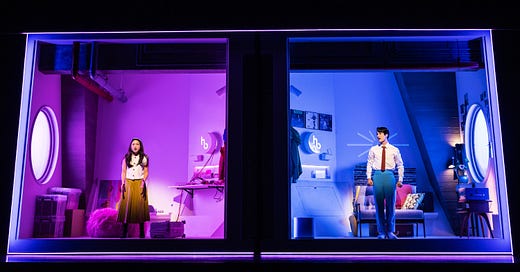HOW MAYBE HAPPY ENDING ENDED UP ON BROADWAY
How a bilingual creative team and an American producer brought one musical to New York across two continents and two languages
Welcome to your weekly guide to the global theater industry. New to Jaques? Check out this handy explainer.
As an exporter, Broadway has a reach that extends across the globe. We all know how it goes: A musical opens in New York, establishes its brand, and then sets out for international markets in Europe, Asia, and beyond, trailing the trophies, critical plaudits and box office success it’s picked up along the way. (Think: The Lion King, Wicked, Chicago, and more recently, Moulin Rouge!)
But as an importer, Broadway sticks almost exclusively to the West End. Shows come over from London all the time, often in the same production and featuring members of the original U.K. cast. (See: This season’s Sunset Boulevard, Tammy Faye, Operation Mincemeat, and Stranger Things: The First Shadow, to name just a few.) Foreign imports come from almost nowhere else.
That’s one of the reasons Maybe Happy Ending, the musical created by the bilingual duo of Hue Park and Will Aronson, is such an intriguing prospect. Now in Broadway previews ahead of its opening on Nov. 12, the show arrives in the U.S. after success at home—but in this case, home isn’t London. It’s Seoul.
How do you bring over a show originally written in another language and try to set it up for Broadway success? Every producer will have a different answer for any given show, and Maybe Happy Ending is just one way to do it. But it can serve as an early case study as more and more international markets have begun to develop original musicals of their own—and producers around the globe show increasing interest in breaking into Broadway.
Speaking of original musicals in international territories: Part 2 of my Manila coverage, focused on the new work that’s coming out of the market there, is coming up in the next SPOTLIGHT STORY. Because Maybe Happy Ending opens on a Broadway in a week, this story jumped ahead of it on the schedule. Stay tuned!
In this SPOTLIGHT STORY, I’ll highlight:
how Maybe Happy Ending first caught the eye of its American producer,
the biggest differences between the Broadway staging and the recent Seoul production,
the notable cast, the elaborate and ambitious set, and the hefty budget of the Broadway staging,
the surprising way the show’s bilingual creative team wrote both the Korean-language version and the English-language iteration in tandem,
the difference between English lyrics and Korean lyrics in tone and content,
a timeline of the show’s success in Seoul and beyond, and
what’s next for its creators.
SUPERSIZED FOR BROADWAY
I saw the most recent South Korean staging of Maybe Happy Ending when I was in Seoul earlier this year. Now that I’ve caught an early preview of the Broadway production, I can tell you: The differences are striking.
On both sides of the Pacific, Maybe Happy Ending is an intimate, emotional fable set in near-future Seoul about two discarded androids who fall in love. In Seoul, the musical has a three-person cast—two actors to play the lead “helper-bots” and a third to play multiple supporting parts—while on Broadway one of those featured roles is given to a fourth actor.
On the Stagecraft podcast, I talked to the stars of the Broadway version, Emmy winner Darren Criss and fast-rising newcomer Helen J. Shen, about international storytelling and finding the humanity in their robotic roles:
The biggest difference between Seoul and New York—and seemingly the biggest risk of this American staging—is Broadway’s elaborate, expensive production design.
Keep reading with a 7-day free trial
Subscribe to Jaques to keep reading this post and get 7 days of free access to the full post archives.




